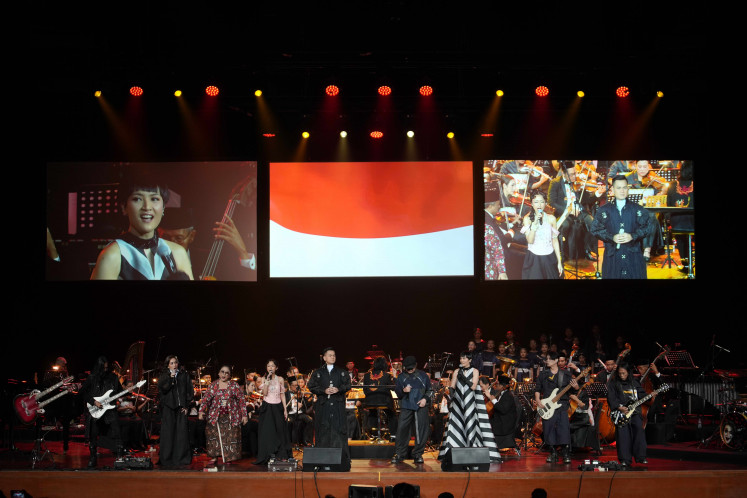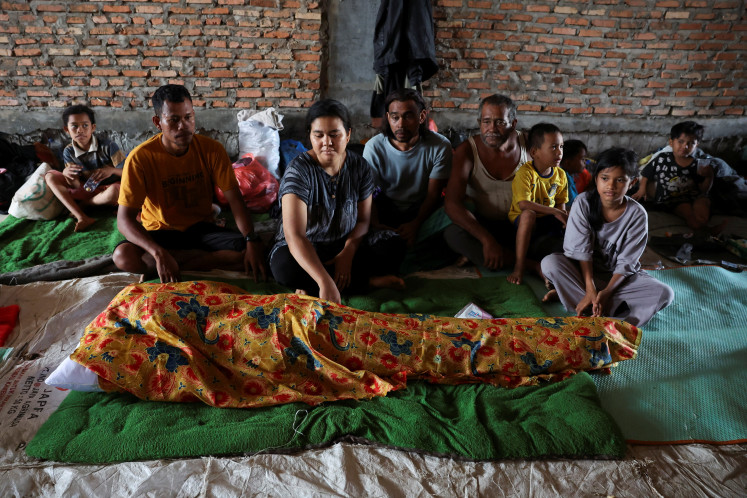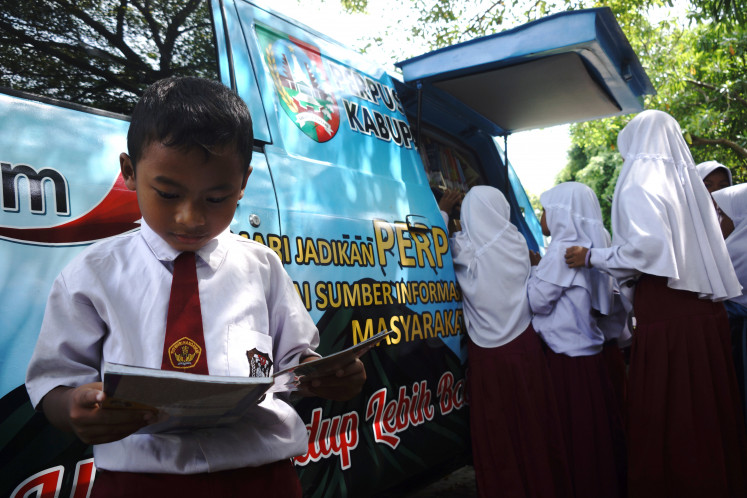Popular Reads
Top Results
Can't find what you're looking for?
View all search resultsPopular Reads
Top Results
Can't find what you're looking for?
View all search resultsBiennale Jogja: A Journey into the 'Hacking Conflict'
People to People by Kainebi OsahenyeThe ongoing Biennale Jogja XIII â Equator #3 brings together the works of 26 Indonesian and 11 Nigerian participants for âHacking Conflict: Indonesia Meets Nigeriaâ
Change text size
Gift Premium Articles
to Anyone
People to People by Kainebi Osahenye
The ongoing Biennale Jogja XIII ' Equator #3 brings together the works of 26 Indonesian and 11 Nigerian participants for 'Hacking Conflict: Indonesia Meets Nigeria'.
If you happen to be in Yogyakarta this month and have the chance to visit Biennale Jogja 2015, do not be surprised when you're asked to line up and register to enter a booth.
You will then be asked to fill out a small pink form at the booth's information and registration counter and leave your ID there before proceeding to a room, bringing with you the pink form and another form to fill out.
'You will need this to get your ID back. Please pay attention to the artwork displayed. You will have to answer a question correctly to get your ID back,' explained the man at the registration counter at the biennale, held at the Jogja National Museum on Jl. Ki Amri Yahya, while pointing to the pink form.
In the next room, you will find a guidance chart attached to a wall from which you can learn how to fill out the bigger form. Or, if you like, you can also request the help of a staff member who will collect the form, and then you wait for your name to be called.
You will then enter a room of your choice to be 'purified' by undergoing a traditional gurah (body organ cleansing) or an interview.
Those choosing to undergo a gurah will have liquid dropped into their eyes and ears.
'Don't worry, this is safe. We have a certificate from the BPOM [Food and Drug Monitoring Agency) for this liquid,' you will be told.
'This is our way of 'hacking' the exhibition. We 'hacked' the entrance,' explained Uma Gumma of Ace House Collective, adding that the work was also meant to criticize bureaucracy.
The National Commission of Art Purification (KNPS) site-specific installation by Ace House Collective is one out of 32 artworks displayed at the main exhibition of Biennale Jogja XIII ' Equator #3, which runs until Dec. 10.
The event is the third in the Equator series, designed and launched in 2010. The first event in 2011 involved participants from India, while the second in 2013 involved participants from Middle-Eastern countries.
Apart from the main exhibition, the biennale is also holding the Equator Festival as a sideline event at the South Literacy Stage in Panggungharjo subdistrict, Bantul, and the Arts and Aesthetic Education Festival for art teachers at the Sidoarum Art House.
Peace song: Dialita Choir, comprising survivors of the 1965 tragedy, receives a warm welcome during a performance at the Biennale. The choir performed four songs, including 'Viva Ganefo', which calls for peace.
The main exhibition's curator, Wok the Rock, said that through the exhibition, he and the participating artists wanted to experiment on how to empower people when faced with conflict, irregularities, misunderstandings and differences.
'Indonesia and Nigeria have many things in common. Both countries went through similar situations following the fall of their respective authoritarian regime, the New Order here and the military in Nigeria, in 1998,' Wok told The Jakarta Post.
Nigerian artist Victor Ehikhamenor reminds the public of the fact that both countries are oil producers, which has placed both countries in their current positions in the global market and politics.
For his installation titled The Wealth of Nations, Ehikhamenor uses oil drums. 'I use oil drums in my work also because of their historical meaning back in Nigeria,' he said, adding that during the Nigerian civil war, oil drums were used to tie up political prisoners and criminals before they were executed.
Wok said that the exhibition was designed to take the form of an activity room collaboratively created by the participating artists, enabling the public to directly interact with the artwork.
'The main exhibition of this year's Biennale Jogja offers a way to enjoy and appreciate a work of art by experiencing it,' Wok said.
Visitors, he said, would need to use all their senses to experience the displayed artwork, with the aim of making people think, sparking a thought or action.
Wok said the main exhibition's participants were deliberately chosen from different professions, including visual artists, theater performers, musicians, journalists, book editors, advertisement professionals and dancers.
Such interactive elements can also be found in Margi Wuto #2 performance and tour by Indonesian theatre director and actor Joned Suryantmoko; Nigerian fine artist Amarachi Okafor's mixed-media painting installation I Learnt This!; and ketjilbergerak community's Taman Tiban (Tiban park).
Wok hopes visitors enjoy the way the Biennale's main exhibition is presented in semi-open spaces despite the high rainfall that has started to pour over Yogyakarta. 'Now we are not working alone. Let's hack this uncomfortable condition together,' he said.
Most works, excluding four, are on display at three different sites at the museum's compound.
The rain can pose a challenge when moving from one exhibition venue to another as there are no connecting corridors. There is also a lack of signs to guide visitors.
'No problem. Maybe this is part of the 'hacking conflict' idea,' said visitor Isnaindra. 'Now it's up to me as a visitor to hack this conflict and just have fun.'
Historical meaning: Biennale Jogja visitors observe an installation piece entitled The Wealth of Nations by Victor Ehikhamenor from Nigeria. The biennale runs until Dec. 10.
' Photos by Bambang M.













